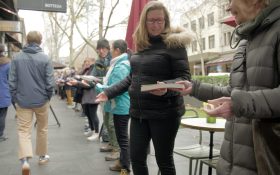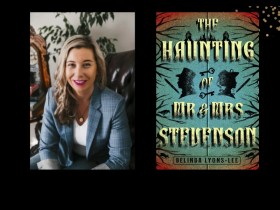Even readers who don’t usually seek out romantic stories are bound to be moved by this compelling true story of a love that changed Australian history. In her debut novel, Alli Parker tells the powerful tale of her grandparents who met in Japan in the immediate aftermath of World War II.
Eighteen-year-old Anglo Aussie Gordon Parker arrived in Kure, Japan from Melbourne in 1946. It was just eight months after the bombing of nearby Hiroshima and he was posted with the 45,000-strong British Commonwealth Occupation Force. While working in the medical unit he met Nobuko Sakuramoto, aka Cherry, a 16-year-old Hiroshima survivor who had lost her mother in the bombing.
The two rapidly fell in love and married, despite the powerful forces ranged against them. Australians were forbidden from fraternising with Japanese, a rule brutally enforced by the military police. Meanwhile, the Japanese community were antagonistic toward the occupying forces of the “ex-enemy soldiers” – ‘murderers [who] had no soul behind their eyes’.
The story does not shy away from darkness – in a moving scene, Gordon visits the obliterated city of Hiroshima. And he and Cherry fall in love against the backdrop of the rubble and ruins of war. We learn, too, about the cold inflexibility of the White Australia policy, which prevented Cherry from joining her husband in Australia. Parker quotes the words of then Immigration Minister Arthur Calwell: ‘It would be the grossest act of public indecency to permit any Japanese of either sex to pollute Australian shores while any relatives remain of Australian soldiers dead in the Pacific battlefields.’
But the darkness is contrasted with the moving facts of this love. Gordon and Cherry kept faith in each other through four years of separation, when voices all around them were telling them to give up. Cherry, stranded in the ruins of Kure with their two toddlers, was ostracised by those who associated her husband with the horrors of Hiroshima. Around her, the wives and children of other Australian soldiers were left abandoned by husbands who returned to Australia. Meanwhile, back in Melbourne, Gordon faced the massive task of changing the White Australia policy to bring his wife home. He, his parents and siblings became the target of death threats and abuse.
Finally, Gordon convinced the right people, and Cherry became the first Japanese war bride to arrive in Australia, clearing the way for others to follow. It’s hard not to cheer the youthful optimism and faith that propelled these two young people to keep fighting for each other against incredible odds. This is a truly Australian story that taps into the resilience of ordinary people caught in the forces of history.
Read: Book review: The In-Between, Christos Tsiolkas
Parker provides us with a compelling depiction of life in Japan in the immediate aftermath of the war, as well as shining a light on the often forgotten history of Australia’s racist policies. But, ultimately, her book is a romantic love story, and its emotional core is the bond Cherry and Gordon maintain despite it all. Her portrayal of her grandparents’ love, persistence and faith in each other reminds us that these forces really are stronger than hatred and war.
At the Foot of the Cherry Tree, Alli Parker
Publisher: HarperCollins
ISBN: 9781460715925
Pages: 336pp
Publication Date: 2 August 2023
RRP: $14.99
This review is published under the Amplify Collective, an initiative supported by The Walkley Foundation and made possible through funding from the Meta Australian News Fund.





